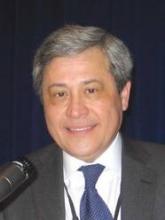SAN ANTONIO – In the not-too-distant future, triple-negative breast cancer that persists after neoadjuvant chemotherapy could potentially be treated with targeted therapies, new data suggest.
At the time of resection performed after neoadjuvant chemotherapy, about 90% of residual tumors have alterations in pathways that could potentially be targeted by agents that are already on the market or in the pipeline, researchers reported at the San Antonio Breast Cancer Symposium. Thus, targeted adjuvant treatment might ultimately reduce the risk of recurrence.
"We believe (these cells) likely mirror the molecular profiles present in the clinically silent micrometastases that are ultimately destined to recur in such patients. If we had knowledge of these molecular alterations, it could provide us some therapeutic impetus to treat patients after surgical resection," according to lead investigator Justin M. Balko, Pharm.D., Ph.D., a research faculty member at the Vanderbilt-Ingram Cancer Center in Nashville, Tenn.
Additional study results suggested that some residual triple-negative breast cancers might be treated effectively with two emerging classes of agents, inhibitors of janus kinase 2 (JAK2) and MEK. Both proteins are involved in cell growth and proliferation.
"These data provide a targetable catalogue of the alterations present in the residual disease of triple-negative breast cancer after neoadjuvant chemotherapy, and we believe that they support genomically driven adjuvant trials in this patient population," Dr. Balko maintained.
"This study is a discovery exercise that to me suggests nothing has changed in clinical care, but it is a strong direction for discovery and research," commented Dr. Carlos Arteaga, moderator of a related press briefing and associate director for clinical research and director of the breast cancer program at Vanderbilt-Ingram Cancer Center.
"If you have patients who have residual disease in the breast after chemotherapy, the standard of care is just to observe those patients. But many of them are going to recur and die from their metastases," noted Dr. Arteaga, who was also a researcher on the study. "The reason we don’t treat them is because we don’t know how to treat them. So this study suggests that there are actionable molecular lesions that we may one day be able to act upon early and potentially change the natural history of that micrometastatic disease that is waiting there to recur in a few months or years."
The investigators obtained residual tumor samples from 114 patients who had completed neoadjuvant chemotherapy for triple-negative breast cancer. They measured immunohistochemical protein expression in 112 tumors and nanostring gene expression in 89 tumors, and performed next-generation sequencing in 81 tumors.
The patients were 48 years old, on average, and most had stage III disease. About half of them had received a taxane as part of their neoadjuvant chemotherapy and were postmenopausal.
The genes most commonly showing amplifications, deletions, or mutations of known or implied functional significance were p53 (altered in about 90% of tumors), MCL1 (an antiapoptotic gene, altered in 55%), and MYC (altered in 30%). But alterations were found, albeit less commonly, in more than 15 other genes as well.
"This heterogeneity highlights a need for personalized medicine in this subgroup" of patients, Dr. Balko commented.
When the altered genes were grouped into pathways, 90% of patients had tumors with at least one affected pathway that could potentially be targeted by agents that are already available or in clinical trials.
The most commonly affected pathways were the PI3 kinase and mammalian target of rapamycin (PI3K/mTOR) pathway (potentially targeted by PI3K/mTOR inhibitors) and the cell cycle pathways (potentially targeted by cell cycle or mitotic spindle inhibitors).
Additionally, alterations were found in the DNA repair pathway (potentially targeted by DNA repair–targeting agents), the Ras/MAPK pathway (potentially targeted by RAF/MEK inhibitors), and growth factor receptor pathways (potentially targeted with receptor tyrosine kinase inhibitors).
Patients whose tumors had high MEK activation and MYC amplification had poorer recurrence-free survival than others (P = .03). In vitro treatment of MYC-overexpressing cells with two MEK inhibitors in clinical trials – selumetinib and trametinib – indeed reduced colony formation.
"This may provide some justification for exploring MEK inhibition within MYC-amplified tumors," Dr. Balko proposed.
In a novel finding, 11% of tumors had amplification of JAK2, which is thought to contribute to cancer cells’ stem cell–like behavior. Compared to others, patients with these tumors also had poorer recurrence-free survival (P = .005) and overall survival (P = .002). They also had higher levels of gene expression of interleukin 6, one of the main cytokines activating this pathway.
"We would like to propose that these JAK2 amplifications may represent a biomarker for clinical trials exploring JAK2 inhibitors that are currently in clinical trials for inflammatory diseases," Dr. Balko said.



